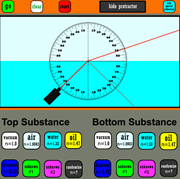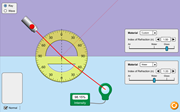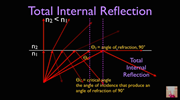Total Internal Reflection - Complete Toolkit
Objectives
- To describe how the relative intensity of a reflected ray and refracted ray at a boundary is dependent upon the angle of incidence.
- To define total internal reflection and to state the conditions that are required in order for a light ray to undergo total internal reflection.
- To define the critical angle, to derive an equation for the critical angle from Snell's law equation, and to use the equation to calculate the critical angle for the boundary between two media.
Readings from The Physics Classroom Tutorial
- The Physics Classroom Tutorial, Refraction and the Ray Model of Light Chapter, Lesson 3
Interactive Simulations
 Refraction Interactive, The Physics Classroom
Refraction Interactive, The Physics Classroom
This simulation from The Physics Classroom allows a learner to explore the reflection and refraction of light at a boundary. Several substances can be chosen as the "Top" and "Bottom" substance. A laser can be dragged to any angle and a ray directed towards the boundary. A protractor allows for the easy measurement of the angles of incidence, reflection and refraction. The brightness of the three rays are indicated on the display.Learners can quickly observe that increasing the angle of incidence leads to an increase in the angle of refraction but also to a dimmer refracted ray and a brighter reflected ray. The Interactive comes with a ready-to-use activity that directs the learner towards the key observations to be found in the Interactive.
 Bending Light, PhET
Bending Light, PhET
This Interactive tool allows the user to explore the reflection and refraction of light at a boundary. Users can choose from some pre-selected materials or choose a customized index of refraction value. Angles of incidence, reflection, and refraction can be measured with a built-in protractor. Light meters allow users to quantitatively measure the intensity of the reflected and refracted light relative to the incident light intensity. Other options are available that do not necessarily shine light upon the topic of total internal reflection.
Video and Animations
 What is Total Internal Reflection
What is Total Internal Reflection
This 10-minute video by Step-by-Step Science discusses the reflection and refraction of light at a boundary and uses several diagrams to demonstrate how an increase in the angle of incidence increases both the brightness of the reflected ray and the angle of refraction. The critical angle is defined and then derived from Snell's Law. A sample problem is performed to determine the critical angle for the water-air boundary.
 Fiber Optic Cables
Fiber Optic Cables
Bill Hammack from the Department of Chemical and Biomolecular Engineering at the University of Illinois explains how optical fibers work and how engineers use them to send messages. The highlight of the 5-minute YouTube video is the demonstration of light piping through a liquid stream of propylene glycol. Reflection and refraction and total internal reflection are masterfully explained. Numerous engineering and communication applications are discussed.
 Total Internal Reflection Demo: Optical Fibers
Total Internal Reflection Demo: Optical Fibers
Professor Boyd F. Edwards explains the importance of total internal reflection and its application to optical fibers. Dr. Edwards does several light-piping demonstrations and explains the physics behind each. The 3-minute video is from the Physics Demos YouTube channel.
Labs and Investigations
- The Physics Classroom, The Laboratory, R and R Lab
Students use laser light and a Lucite hemicylindrical prism to investigate the effect of the angle of incidence upon the relative brightness of the reflected and transmitted ray.
- The Physics Classroom, The Laboratory, A Critical Lab
Students experimentally determine the critical angle for the air-water boundary and the air-Lucite boundary.
Link: http://www.physicsclassroom.com/lab/refrn/RLlabs.html
Demonstration Ideas
 Total Internal Reflection
Total Internal Reflection
This 1.5-minute video features a demonstration in which a beam of light is directed into a hemicylindrical block of glass. The light approaches along the curved side of the cylinder along the radial line so that there is no refraction upon entering the block. Refraction occurs at the flat edge of the block. The demonstration is performed on top of paper with angle markings. The angle of incidence at the glass-to-air boundary begins at 0° and is slowly increased. As angles get larger, the reflected light at the glass-to-air boundary becomes visible. As the angle continues to increase, the refracted light becomes dimmer and dimmer and the reflected light becomes brighter and brighter. At the critical angle, the refracted ray appears along the boundary and further increases in the angle of incidence shows that the refracted ray disappears.
-
 Laser Viewing Tank
Laser Viewing Tank
Designed by California Physics Teacher Dean Baird, this versatile system allows students to see and control light beams. Scattering agent added to water in the plastic tank make laser beams visible. Students easily control observations involving simple refraction and total internal reflection. Watch as physics teacher Robert Douglas discuss this great teaching tool. Students love laser demos, keep the excitement coming with this demo!
Minds On Physics Internet Modules:
The Minds On Physics Internet Modules are a collection of interactive questioning modules that target a student’s conceptual understanding. Each question is accompanied by detailed help that addresses the various components of the question.
- Refraction and Lenses, Ass’t RL5 - Total Internal Reflection
- Refraction and Lenses, Ass’t RL6 - TIR and the Critical Angle
Concept Building Exercises:
- The Curriculum Corner, Refraction and Lenses, Total Internal Reflection
Problem-Solving Exercises:
- The Calculator Pad, Refraction and Lenses, Problems #13-#18
Link: http://www.physicsclassroom.com/calcpad/refrn/problems
Science Reasoning Activities:
- Reflection and Transmission
Link: http://www.physicsclassroom.com/reasoning/refraction
Real Life Connections:
 Passive Fiber Optics
Passive Fiber Optics
This multi-part tutorial provides a considerable wealth of detail on the guiding of a light beam through an optical fiber. It is an excellent source of information for teachers who wish to strengthen their understanding of fiber optics.
 Rainbow Formation
Rainbow Formation
The physics that underlies the formation of rainbows is extensively and systematically explained in this video by VSauce. In his usual intriguing manner, VSauce producer Michael Stevens describes several types of rainbows using a variety of images and explains the conditions under which they are formed. While there is a minimal amount of information about refraction and internal reflection, the video provides valuable information that answers a variety of our most curious students' questions.
Standards:
A. Next Generation Science Standards (NGSS)
Crosscutting Concepts
Patterns:
- Different patterns may be observed at each of the scales at which a system is studied and can provide evidence for causality in explanation of phenomena.
Systems and System Models:
- Models (e.g., physical, mathematical, computer models) can be used to simulate systems and interactions – including energy, matter, and information flows – between and within systems at different scales.
- Develop and use models (physical, mathematical, and computer models) to predict the behavior of a system and design systems to do specific tasks.
Scale, Proportion, and Quantity
- Algebraic thinking is used to examine scientific data and predict the effect of a change in one variable on another.
Science and Engineering Practices
Practice #1: Analyzing and Interpreting Data
- Analyze data using tools, technologies, and/or models (e.g., computational, mathematical) in order to make valid and reliable scientific claims.
Practice #2: Developing and Using Models
- Develop and use a model based on evidence to illustrate the relationships between systems or between components of a system.
- Use a model to provide mechanistic accounts of phenomena.
Practice #3: Planning and Carrying Out Investigations
- Plan and conduct an investigation individually and collaboratively to produce data to serve as the basis for evidence, and in the design: decide on types, how much, and accuracy of data needed to produce reliable measurements.
Practice #6: Constructing Explanations
- Construct an explanation that includes qualitative or quantitative relationships between variables that predict phenomena.
- Construct and review an explanation based on valid and reliable evidence obtained from a variety of sources (including students’ own investigations, models, simulations, and peer review) and the assumption that theories and laws that describe the natural world operate today as they did in the past and will continue to do so in the future.
Practice #7: Engaging in Argument from Evidence
- Make and defend a claim based on evidence about the natural world that reflects scientific knowledge and student-generated evidence.